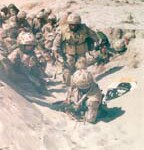
WEDNESDAY, July 20 (HealthDay News) — Some U.S. soldiers returning from Iraq and Afghanistan are suffering unexplained breathing problems that may be related to exposure to unknown toxins, a new study indicates.
“Respiratory disorders are emerging as a major consequence of service in southwest Asia,” said study author Dr. Matthew S. King, an assistant professor of pulmonary and critical care at Meharry Medical College in Nashville, Tenn.
“In addition to our study, there have been studies showing increases in asthma, obstructive lung disease, allergic rhinitis and a general increase in reports of respiratory symptoms,” he added.
The report was published in the July 21 issue of the New England Journal of Medicine.
For the study, King and colleagues had 80 soldiers with difficulty breathing from Fort Campbell, Ky., undergo physical exams that included tests to determine how well they were breathing and CT scans.
In addition, 49 soldiers had lung biopsies when the exam couldn’t find a reason for their breathing problems. Some of these soldiers had been exposed to a sulfur-mine fire in Iraq in 2003, the researchers noted.
All the biopsies were abnormal, and the researchers diagnosed 38 soldiers with constrictive bronchiolitis. Constrictive bronchiolitis is a rare non-reversible lung disease in which the small airways in the lungs are compressed and narrowed by scar tissue or inflammation.
“This a very rare condition in otherwise healthy individuals and is generally untreatable,” King said. “We believe that it is caused by an inhalational exposure with which they have contact while in southwest Asia.”
The other soldiers were diagnosed with other conditions that explained their breathing problems.
All those with constrictive bronchiolitis had normal chest X-rays, but about 25 percent had nodules in their lungs that were related to their breathing problems, King’s team reported.
And, while the results of the breathing tests were within normal ranges, they were worse than seen in other soldiers, the researchers found.
“The evidence that an inhalational exposure is the likely underlying cause of these problems is mounting, and we owe it to our military to launch further investigations so that we may improve prevention, detection, and treatment of these deployment-related respiratory diseases,” King said.
Dr. Michael Light, a professor of pulmonary medicine at the University of Miami Miller School of Medicine, said that “pulmonary abnormalities probably are real after exposure to whatever it might be, from Middle Eastern deployments.”
However, whether the people who live in these areas have similar problems isn’t known, Light said. “They’re exposed to the same things,” he said. “We don’t know if they get this problem.”
The theory is this is caused by the inhalation of a toxic substance in people who have not been exposed to it before, Light said. However, he noted that the damage seems to be minor. These same problems were seen during the first Gulf War, he added.
Whether the problem is permanent isn’t clear, Light said. “There are treatments,” he added. These include steroids and Zithromax, an antibiotic used to treat bronchitis and pneumonia.
“This is a wake-up call that there may be ways that can reduce the impact of these exposures,” Light said.
More information
For more on lung diseases, visit the U.S. National Library of Medicine.

